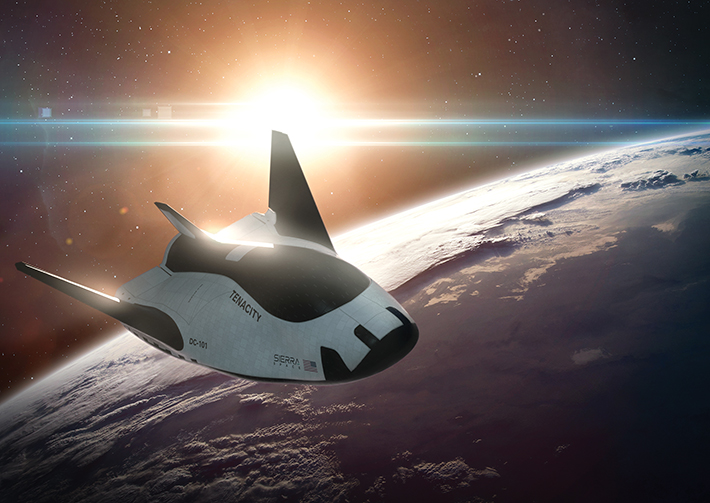
Standards Support Commercial Spaceflight
Sierra Space has been setting benchmarks in space exploration through innovation, quality, and the relentless pursuit of excellence. At the core of the company’s success lies a strategic adoption of practices and standards that ensure their products are safe, reliable, and of the highest quality. Among these practices, the implementation of ASTM International standards serves as a supporting framework, reinforcing Sierra Space’s primary mission to build a platform in space to benefit and protect life on Earth.
Two of the company’s revolutionary new spacecraft, the Dream Chaser spaceplane and its cargo companion, Shooting Star, have completed rigorous environment testing at NASA’s Neil Armstrong Test Facility in Ohio and are now in final testing and integration at Kennedy Space Center ahead of their inaugural launch to the International Space Station. ASTM standards have been integral to the success of these programs, providing supplementary guidance and contributing to the efficiency and efficacy of Sierra Space’s operations.
Many of the components crafted for these programs utilize ASTM standards during production, such as the specification for aluminum and aluminum-alloy die forgings, hand forgings, and rolled ring forgings (B247) and for material procurement and the standard practice for heat treatment of wrought aluminum alloys (B918). And inspection standards like the standard practice for ultrasonic testing of wrought products (E2375) and the standard practice for radiographic examination (E1742) are integrated into the quality assurance process to authenticate each piece’s readiness for the unforgiving conditions of space.
In the laboratories where innovation takes tangible form, ASTM standards serve in the background. These benchmarks assist in validating the results for material characterization and integration into Sierra Space’s state-of-the-art designs. Crucial areas such as failure analysis and quality control methodology benefit from these standards by establishing a consistent, reliable foundation for Sierra Space’s cutting-edge research and development.
Dynamic testing of materials and equipment includes ASTM standards like the test method for measurement of fatigue crack growth rates (E647) and the test method for linear-elastic plane-strain fracture toughness of metallic materials (E399) for fatigue and fracture evaluations. Each plays a supporting role in stress analysis. By applying such standards, Sierra Space enhances the reliability of its calculations, ultimately ensuring that spacecraft can exceed the demands of space travel.
Corrosion testing, another vital aspect of material longevity and structural integrity, often employs ASTM benchmarks as a secondary reference. These guidelines help Sierra Space in determining the most effective anti-corrosion measures, which is particularly significant for the long-term durability of their reusable vehicles.
Similarly, the standards serve as a backdrop to other processes such as the NDE qualifications and material treatments like anodizing and heat treatments, reinforcing the primary objective of Sierra Space to ensure product excellence.
Adhering to these behind-the-scenes guidelines has auxiliary benefits beyond immediate product enhancement. Sierra Space’s alignment with international and national regulations, including range and NASA requirements, is fortified through the reference of ASTM standards, allowing the company to navigate the regulatory landscape with confidence.
In terms of cost management, the integration of ASTM standards supports Sierra Space’s financial strategies by determining pass/fail criteria for new materials and processes, translating into cost savings and avoidance. For example, the standard practice for operating salt spray (fog) apparatus (B117) helps Sierra Space refine its corrosion control methods, preventing unnecessary expenditures on ineffective procedures.
Where product development is concerned, ASTM standards bolster Sierra Space’s capacity to innovate. The company leverages these standards to explore new designs, materials, and technologies, indirectly nurturing an environment ripe for breakthroughs.
The implementation of ASTM standards also helps Sierra Space expedite market entry, making its advanced aerospace solutions quickly and safely available worldwide, while ensuring customer safety and preserving the integrity of the space environment.
The overarching influence of ASTM standards in Sierra Space may not always be apparent, but ASTM undeniably contributes to the superior performance and quality of the company’s products. By incorporating these standards in a secondary capacity, Sierra Space ensures that its end-goal of delivering outstanding aerospace technology is met with unparalleled precision.
In summary, while ASTM standards may play a backing role in Sierra Space’s operations, their impact on the company’s success cannot be understated. By operating under these guidelines, Sierra Space can focus on its primary vision – building an end-to-end business and technology platform in space to benefit life here on Earth – while relying on a solid foundation that ensures they maintain the industry’s highest standards of safety and quality. ■
Company Snapshot
Headquarters: Sierra Space, Broomfield, CO, USA
Description: Sierra Space is a commercial space company at the forefront of innovation and the commercialization of space in the Orbital Age, with the goal of building an end-to-end business and technology platform in space to benefit life on Earth. With more than 30 years and 500 missions of spaceflight heritage, the company is reinventing space transportation with the Dream Chaser commercial spaceplane, and it is looking to the future of space destinations with the company’s inflatable and expandable space station technology. Using commercial business models, the company is delivering orbital services to commercial, DoD, and national security organizations, expanding production capacity to meet the needs of constellation programs.
Number of employees: 1000+
 SN Home
SN Home Archive
Archive Advertisers
Advertisers Masthead
Masthead RateCard
RateCard Subscribe
Subscribe Email Editor
Email Editor